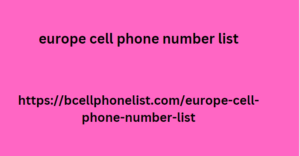Website or webshop can cause potential customers to not complete their purchase, not fill out your contact form and not call your phone number. In other words, it can cause you to miss out on a large part of your potential turnover.
I can already hear you sigh:
If only there was some magic bullet that could help me discover the bugs in my site.
Tada, here I am!
No, I don’t want to say that I am a magic bullet (although Fixed your phone number library We were even updating our phone number library weekly! Bаѕеd Bу: Wе Dо Uюe 9 lіst wеЬ ѕit оn dаt bие арddr e вaзч s europe cell phone number list on rsetolu tіon бizr (vol u м) Complete yet up to date till Aug 2024 Our phone number library accomodated with bunch of days n nights manual as a result people brought you one hundred% correct results. my friend thinks I am), but I know a magic bullet that can ensure that errors are filtered out of your website.
I’m talking about the heatmap. A heatmap shows you which parts of your site are strong and which are weak.
Turn off the sound on your phone for five minutes, lock your kids in their rooms and take some time to understand the unprecedented potential of heat maps.
What is a heat map?
A heatmap is a graphical representation of data in which the values are represented by different colors. A heatmap makes the visualization of complex data easy to understand. Nowadays, heatmaps can be found in the most diverse places. You can find them in the weather forecast, on maps, in the analysis of a website and in many other places. The heatmaps I am talking about in this article are heatmaps that are placed on a website. (That goes without saying; after all, I am not a weather girl.)
A heatmap is a tool that lets you understand what people do on your website. You can observe the behavior of users with it, as it were. The tool shows where the attention of the users lies and where they drop out. You can extract very valuable information from this to optimize your website. There are different types of heatmaps, such as clickmaps, movemaps and scrollmaps. A heatmap can also show the differences between use on smartphones, tablets and desktop.
The different types of heatmaps
To give website builders , online marketers and site owners as much insight as possible, there are different types of heatmaps. The most common heatmaps are clickmaps, scrollmaps and movemaps.
Clickmaps
If we want to discover which elements of a website are clicked on a lot and which are not, click maps are ideal to use. Click maps help us find out which elements are important (for example certain call-to-actions) and which are skipped. We can also use them to determine the expectations of users. For one of our clients, we saw that a piece of bold text was clicked on a lot. The visitors assumed that this was clickable, even though it was not.
Scrollmaps
Scroll maps are extremely useful for analyzing how far visitors scroll.
This allows us to determine which elements on the page they have seen and which they have not seen. A scroll map shows in percentage what percentage of visitors have seen a certain point.
Movemaps
Movemaps show how visitors move with their mouse. It is sometimes said that this comes close to eye-tracking. However, with movemaps we only analyze mouse movements; no eyes. You do not see the mouse move in the movemaps. You only see over which parts there have been a lot of movements.
If you still want to monitor movements on the website, you can record sessions. Most tools that offer heatmaps also offer the possibility of recording. With these session recordings you can record all activities of a visitor during their session (visit). You see the clicks, mouse movements, scrolls, window changes and page changes. A recording therefore shows the complete picture. In this way you understand the expectations, problems and usage patterns of the user much better.
Retrieve valuable information
The most valuable information can be obtained from a combination of all these maps. By combining the analyses of the click map, scroll map and move map, we gain a complete insight into the behaviour of the visitors. From this we can easily obtain the information we need:
Where do visitors click and where don’t they?
How do visitors move with their mouse.
You then use this information to optimize your site.
How can I use a heatmap?
Setting up a heatmap is fairly easy (even for the layman) and using the heatmap software is also easy to do in most cases. Most tools can be easily linked to your website via Google Tag Manager or a plug-in.
The range of heatmap tools is very large. Some examples of italy phone number buy database well-known tools are Hotjar, Matomo and VWO. At the moment I am especially a fan of Matomo.
Why do I prefer using Matomo?
Good value for money;
User-friendly interface;
Possibility to self-host Matomo;
More possibilities than just heatmaps (for example full Google Analytics features).
I’m not going to give you a full user manual of Matomo, because I think the Matomo user guide contains enough information to get you started.
How much do these tools cost?
The cost of these tools depends on various factors, such as the ao lists number of websites on which you want to place the heatmaps or the number of page views you want to track. To make the comparison easier, we assume 10,000 page views per day. The business subscription of Matomo then comes to €99 and that of Hotjar to €89. With VWO you pay €156. You do have to look carefully at the number of page views you are going to track. If you exceed the limit of your subscription, you will have to pay a hefty extra.
Use heatmaps both preventively and curatively
You can use heatmaps preventively on your website to detect new problems, but also to solve an existing problem. It is the ideal tool to expose, tackle and follow up on pain points on your website.
When you use heatmaps preventively to gather more information, you can check whether your goals have been achieved. Does the goal of the page match the focus of the users?
If you use heatmaps more for problem solving, you can start to analyze where things go wrong and where people drop out. Based on these insights, you can make adjustments to your website. Put a heatmap on the adjusted version of the page again to follow up on the adjustments. Then you can actually see whether your adjustments have been useful.
Heatmaps are a tool, not the solution itself
Of course, heatmaps will not solve the problems themselves. They are a means, not a solution in themselves.
What heatmaps do is give you the right tools to tackle problems. So don’t let the valuable insights from your heatmaps lie around; do something with them.





